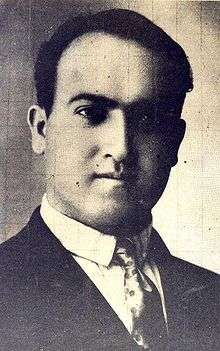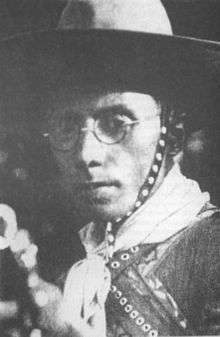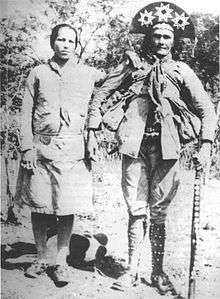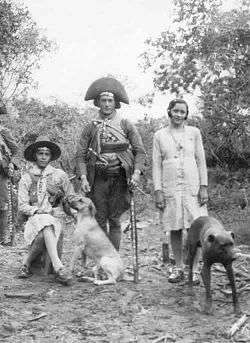Benjamin Abrahão Botto

Benjamin Abrahão Botto (Lebanon, c. 1890 - Serra Talhada, May 10, 1938) was an photographer, more known for the registration the Cangaço and its leader Virgulino Ferreira da Silva. Benjamin Abrahão Botto was murdered during the Estado novo period in Brazil.
Biography
Not much is known about his life prior to his departure for Brazil. Not pretending to be on the list of conscripts of the Ottoman Empire that was set to fight in the First World War, he migrated to Brazil in 1915.[1] In Recife, started working as a traveling salesman, selling cloths and small goods. Attracted by the frequency of pilgrims in the city of Juazeiro do Norte, he moved his business to those more attractive regions.[2] Abahão was the secretary of Padre Cícero and met the cangaceiro Lampião in 1926 when the infamous leader went to Juazeiro do Norte to ask for the blessing of the famous priest and seek the rank of Captain, by helping the government in the pursuit of the Coluna Prestes.[3]
In 1929 Abahão photographed the cangaceiro leader with the priest, two of the most mythological figures of the northeast region of Brazil After the death of Padre Cícero, Abrahão asked and received from the infamous Lampião, the permission to follow his group in the Caatinga and take the pictures that in the future would immortalize them. For that he had the help of the cearense Ademar Bezerra de Albuquerque, owner of ABAFILM, not only borrowed him the equipment but also taught him to use them. Abrahão had his works apprehended by the Getúlio Vargas government, which saw him as an enemy of the regime. He was violently murdered (forty two knife stabs[4]) without neither the author nor the motivation for the crime ever being brought to light.[2]
Lampião's Letter
Lampião himself wrote a letter, certifying that his pictures were taken by Benjamin Abrahão Botto.[3]
Note: The text below is a translation from the Portuguese original letter wrote by Lampião. It is important to highlight that Lampião was semi-alphabetized and the text may have many incorrections in the portuguese version
Honourable Mr. Benjamim Abrahão
Greetings.
I come to tell that you were the first person that could record me with all my cangaceiro personal, recording all our movement of our life in the Caatingas of the Northeast’s sertões.
Other people could not, nor they will, nor I will allow it anymore.
No more, from the friend
Captain Virgulino Ferreira da Silva
A.K.A. Captain Lampião.
— Captain Virgulino Ferreira da Silva, Letter to Benjamin Abrahão Botto
Recordings
To realize this task Abrahão had to work out a very difficult approach to the group that was running away from the increasingly violent pursuit from the government. The meeting finally occurred in an isolated place of the Brazilian Caatinga, where the cangaceiro leader, very suspicious of the man's intentions, himself did the first recordings with the photographical equipment. Only after that he allowed Abrahão to record him and the group. Abrahão then returned to Fortaleza showing the successful achievement of his objective and managed to obtain more resources to go back and take more pictures of Lampião and his group. Some started considering Abrahão a suspect because not only he sent pictures and articles to newspapers describing his adventures, but also for his knowledge of the whereabouts of the group.[2]
Abandon and rescue
In April 7, 1937, the newspapers transcribed the order from the director of the national Department of Press and Propaganda (Departamento de Imprensa e Propaganda-DIP) that determined the apprehension of the movie “Lampião”.[3]
Here is the content of the transcription:[4]
Secretary of Public Security of the Ceará State. Came to the knowledge of the National Department of Press and Propaganda that is being announced or exhibited in the capital or in the cities of your state, a movie about Lampião, property of “Aba Filmes” located in the street Major Facundo. I request the immediate apprehension of the cited movie, with all its copies and negatives to be sent to this department. The negotiation of this movie with third parties should be avoided for the movie not to leave Brazil.
Regardful greetings.
— Lourival Fontes, Director of the national Department of Press and Propaganda
The works of Abrahão Botto, were completely forgotten until the 50s when the Getúlio Vagas Foundation incorporated the works. In 1999, the eventful life of the photographer was the subject of the movie Perfumed Ball.[5] In 2000, his work was presented in many expositions in Paris, São Paulo and Rio de Janeiro.[6]
References
- ↑ CHIODETTO, Élder Archived April 18, 2009, at the Wayback Machine., notícia na Folha de S.Paulo, transcrição (página acessada em 12 de fevereiro de 2008).
- 1 2 3 Artigo: MONTEIRO, Fernando. Cinema e cangaço na terra do sol in: revista História Viva, edição 23 - Setembro 2005 (página acessada em 12 de fevereiro de 2008).
- 1 2 3 Matéria Archived March 11, 2008, at the Wayback Machine., Virtual Books, página pesquisada em 12 de fevereiro de 2008.
- 1 2 3 Matéria Archived March 28, 2007, at the Wayback Machine., Virtual Books, página pesquisada em 12 de fevereiro de 2008.
- ↑ História do filme Archived March 4, 2016, at the Wayback Machine., com sinopse, e breve biografia de Benjamin Abrahão (página pesquisada em 12 de fevereiro de 2008).
- ↑ Notícia, in: Folha de S.Paulo, de 9 de outubro de 2000 (página pesquisada em 11 de fevereiro de 2008)
External links
| Wikimedia Commons has media related to Benjamin Abrahão Botto. |







